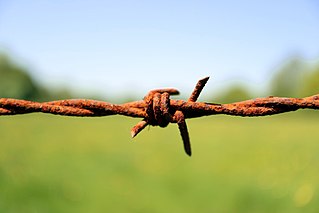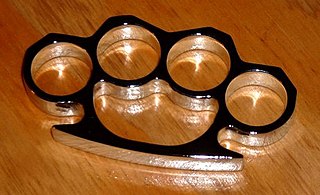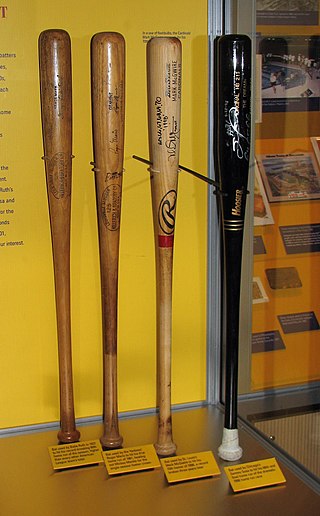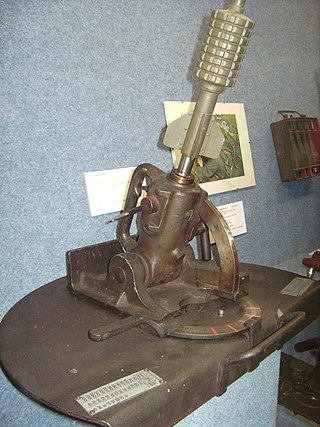
A mace is a blunt weapon, a type of club or virge that uses a heavy head on the end of a handle to deliver powerful strikes. A mace typically consists of a strong, heavy, wooden or metal shaft, often reinforced with metal, featuring a head made of stone, bone, copper, bronze, iron, or steel.

Barbed wire, also known as barb wire, is a type of steel fencing wire constructed with sharp edges or points arranged at intervals along the strands. Its primary use is the construction of inexpensive fences, and it is also used as a security measure atop walls surrounding property. As a wire obstacle, it is a major feature of the fortifications in trench warfare.

A bayonet is a knife, dagger, sword, or spike-shaped melee weapon designed to be mounted on the end of the barrel of a rifle, carbine, musket or similar long firearm, allowing the gun to be used as an improvised spear in close combats.

Trench warfare is a type of land warfare using occupied lines largely comprising military trenches, in which combatants are well-protected from the enemy's small arms fire and are substantially sheltered from artillery. It became archetypically associated with World War I (1914–1918), when the Race to the Sea rapidly expanded trench use on the Western Front starting in September 1914.

In the military science of fortification, wire obstacles are defensive obstacles made from barbed wire, barbed tape or concertina wire. They are designed to disrupt, delay and generally slow down an attacking enemy. During the time that the attackers are slowed by the wire obstacle they are easy to target with machine gun and artillery fire. Depending on the requirements and available resources, wire obstacles may range from a simple barbed wire fence in front of a defensive position, to elaborate patterns of fences, concertinas, "dragon's teeth" and minefields hundreds of metres thick.

Brass knuckles are a melee weapon used primarily in hand-to-hand combat. They are fitted and designed to be worn around the knuckles of the human hand. Despite their name, they are often made from other metals, plastics or carbon fibers and not necessarily brass.

A club is a short staff or stick, usually made of wood, wielded as a weapon or tool since prehistory. There are several examples of blunt-force trauma caused by clubs in the past, including at the site of Nataruk in Turkana, Kenya, described as the scene of a prehistoric conflict between bands of hunter-gatherers 10,000 years ago.

A baseball bat is a smooth wooden or metal club used in the sport of baseball to hit the ball after it is thrown by the pitcher. By regulation it may be no more than 2.61 inches (6.6 cm) in diameter at the thickest part and no more than 42 inches (1.067 m) in length. Although historically bats approaching 3 pounds (1.4 kg) were swung, today bats of 33 ounces (0.94 kg) are common, topping out at 34 to 36 ounces.
A stiletto is a specialized dagger with a long slender blade and needle-like point, primarily intended as a thrusting and stabbing weapon.

A trench knife is a combat knife designed to kill or incapacitate an enemy at close quarters, such as in a trench or other confined area. It was developed as a close combat weapon for soldiers attacking enemy trenches during the First World War. An example of a World War I trench knife is the German Army's Nahkampfmesser.

Trench raiding was a feature of trench warfare which developed during World War I. It was the practice of making small scale night-time surprise attacks on enemy positions.
A combat knife is a fighting knife designed for military use and primarily intended for hand-to-hand or close combat fighting.

An entrenching tool (UK), intrenching tool (US), E-tool, or trenching tool is a digging tool used by military forces for a variety of military purposes. Survivalists, campers, hikers, and other outdoors groups have found it to be indispensable in field use. Modern entrenching tools are usually collapsible and made using steel, aluminum, or other light metals.

The tekkō, are weaponized stirrups and horseshoes which originated in Okinawa, Japan, and they fall into the category of "fist-load weapons". By definition, a fist-load weapon increases the mass of the hand so that, given the physical proportionality between the fist's momentum and its mass, it increases the force the bearer can deliver. Some fist-load weapons may also serve, in the same manner, as the guard on a sword, to protect the structure of the bearer's hand.

A push dagger is a short-bladed dagger with a "T" handle designed to be grasped and held in a closed-fist hand so that the blade protrudes from the front of the fist, either between the index and middle fingers or between the two central fingers, when the grip and blade are symmetrical.

Wiring parties,, were used during World War I on the Western Front as an offensive countermeasure against the enemy’s barbed wire obstacles. Though hazardous and stressful duty, work was done at night to repair, improve, and rebuild their own wire defences, while also sabotaging and cutting the enemy's. In battles all across the Western Front, cutting parties were successful in creating breaches in the wire lines, offering their comrades a better chance to cross no man's land.
Barbed wire was one of the attacker's great problems. There were cutters, but not enough, and men were often killed before they could cut a way.

The Mark I trench knife is an American trench knife designed by officers of the American Expeditionary Force (AEF) for use in World War I. It has a 6.75 in (17.1 cm) double-edged dagger blade useful for both thrusting and slashing strokes, unlike previous U.S. trench knives such as the M1917 and M1918. The handle is made of cast bronze and uses a conical steel nut to hold the blade in place. The Mark I's blade was blued with a black oxide finish, the bronze handle was chemically blackened, with cast spikes on the bow of each knuckle. The spikes were intended to prevent an opponent from grabbing the knife hand, as well as to provide a more concentrated striking surface when employed in hand-to-hand combat.

The M3 trench knife or M3 fighting knife was an American military combat knife first issued in March 1943. The M3 was originally designated for issue to soldiers, not otherwise equipped with a bayonet. However, it was particularly designed for use by forces in need of a close combat knife, such as Airborne Units and Army Rangers, so these units received priority for the M3 at the start of production. As more M3 knives became available in 1943 and 1944, the knife was issued to other soldiers such as Army Air Corps crewmen and soldiers not otherwise equipped with a bayonet, including soldiers issued the M1 carbine or a submachine gun such as the M3 submachine gun "grease gun".

An improvised weapon is an object that was not designed to be used as a weapon but can be put to that use. They are generally used for self-defence or if the person is otherwise unarmed. In some cases, improvised weapons are commonly used by attackers in street fights, muggings, murders, gang warfare, during riots, or even during insurgencies, usually when conventional weapons such as firearms are unavailable or inappropriate.

The kleineGranatenwerfer 16 or Gr.W.16(Small Grenade Launcher Model 1916) in English, was an infantry mortar used by the Central Powers during the First World War. It was designed by a Hungarian priest named Father Vécer and was first used by the Austro-Hungarian Army in 1915. In Austro-Hungarian service, they received the nickname "Priesterwerfers". In 1916 Germany began producing a modified version under license for the Imperial German Army.



















